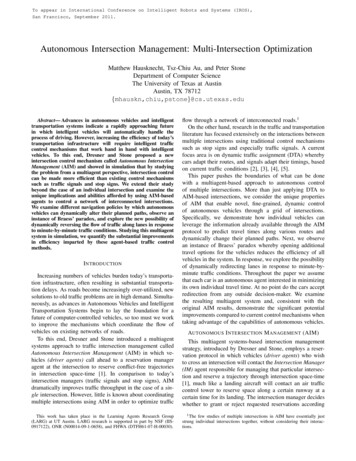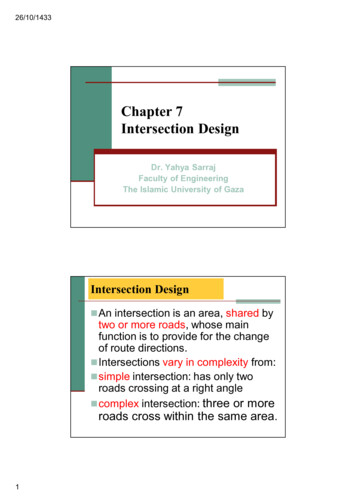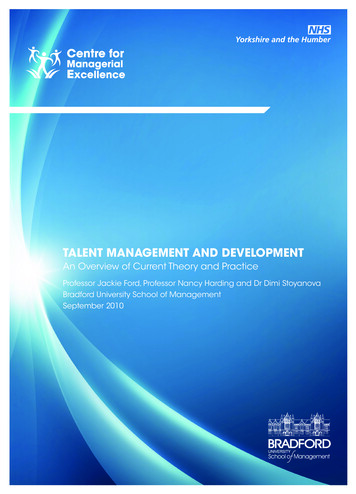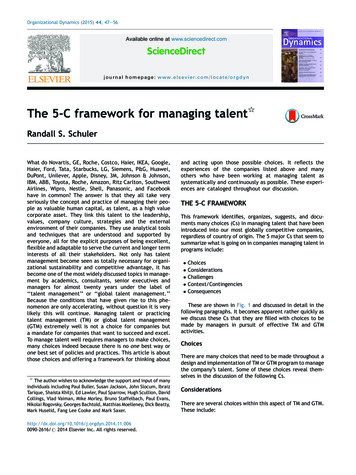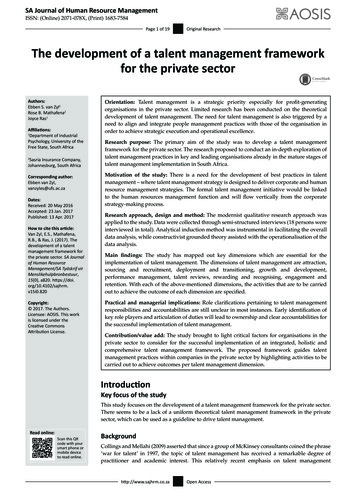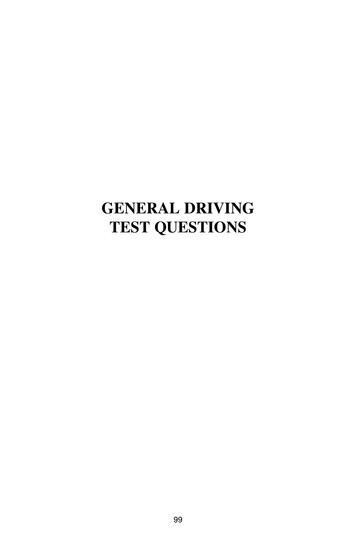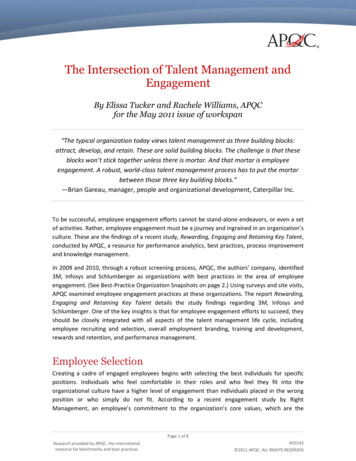
Transcription
The Intersection of Talent Management andEngagementBy Elissa Tucker and Rachele Williams, APQCfor the May 2011 issue of workspan“The typical organization today views talent management as three building blocks:attract, develop, and retain. These are solid building blocks. The challenge is that theseblocks won’t stick together unless there is mortar. And that mortar is employeeengagement. A robust, world-class talent management process has to put the mortarbetween those three key building blocks.”—Brian Gareau, manager, people and organizational development, Caterpillar Inc.To be successful, employee engagement efforts cannot be stand-alone endeavors, or even a setof activities. Rather, employee engagement must be a journey and ingrained in an organization’sculture. These are the findings of a recent study, Rewarding, Engaging and Retaining Key Talent,conducted by APQC, a resource for performance analytics, best practices, process improvementand knowledge management.In 2009 and 2010, through a robust screening process, APQC, the authors’ company, identified3M, Infosys and Schlumberger as organizations with best practices in the area of employeeengagement. (See Best-Practice Organization Snapshots on page 2.) Using surveys and site visits,APQC examined employee engagement practices at these organizations. The report Rewarding,Engaging and Retaining Key Talent details the study findings regarding 3M, Infosys andSchlumberger. One of the key insights is that for employee engagement efforts to succeed, theyshould be closely integrated with all aspects of the talent management life cycle, includingemployee recruiting and selection, overall employment branding, training and development,rewards and retention, and performance management.Employee SelectionCreating a cadre of engaged employees begins with selecting the best individuals for specificpositions. Individuals who feel comfortable in their roles and who feel they fit into theorganizational culture have a higher level of engagement than individuals placed in the wrongposition or who simply do not fit. According to a recent engagement study by RightManagement, an employee’s commitment to the organization’s core values, which are thePage 1 of 8Research provided by APQC, the internationalresource for benchmarks and best practicesK03142 2011 APQC. ALL RIGHTS RESERVED
essence of organizational culture, was cited as the No. 1 potential driver of employeeengagement.To identify the job candidates who are most likely to fit in and become engaged employees,best-practice organizations leverage their high-potential and high-value talent as recruiters. Inthe Rewarding, Engaging and Retaining Key Talent study, for example, Schlumberger, an oilfieldservices provider, shared how it relies on field recruiters and other technical experts sourcedfrom its high-value employee population to recruit and select new technical talent.Schlumberger found that this practice provides two advantages. First, the high-value employeesfeel as though they are helping shape the future of the organization by influencing the hiring ofkey talent. Second, these engineers-turned-recruiters ensure that enthusiasm for working atSchlumberger, core organizational values and information about job opportunities areaccurately communicated to applicants. They are also able to identify applicants who will fit theSchlumberger culture.Infosys, an information technology services organization, hires for attitude and passion, andtrains for talent. In order to assess the cultural fit, passion and engagement of potential newhires, Infosys leverages a panel of high-potential supervisors and managers — varying between800 and 2,000 individuals at any one point in time — that recruit and represent Infosys oncollege campuses. This panel undergoes extensiveBest-Practice Organizationtraining and coaching to appropriately communicateSnapshotswith candidates, showcase careers at Infosys and gaugeapplicant fit for the organization.3MSt. Paul, Minn.(headquarters)74,835 employees (2009) 23.1 billion (2009)Diversified manufacturingInfosysBangalore, India(headquarters)113,800 employees (2010) 4.8 billion (2010)Information technologyservicesSchlumbergerHouston, Texas(headquarters)108,000 (2010) 27.4 billion (2010Oilfield servicesEmployment BrandingBest-practice organizations recognize that theiremployment brands and corporate reputations arecritical factors in engaging current employees (as wellas in recruiting and selecting individuals who are likelyto become engaged employees in the future).According to Gallup, organizations with a strongemployment brand benefit from a number ofadvantages, including higher levels of employeeengagement. Therefore, best-practice organizationsformally brand themselves as employers of choice,create and communicate these brands to employees,and use the brands to reach out to potential talentpools in local communities, schools and universities.For example, 3M has a unique culture based oncollaboration and the freedom to innovate. ThePage 2 of 8Research provided by APQC, the internationalresource for benchmarks and best practicesK03142 2011 APQC. ALL RIGHTS RESERVED
engagement and measurement team at 3M believes employee engagement leads to customerengagement, which in turn leads to increased customer share and increased sales revenue. 3Mhas created an integrated employment brand model that integrates consistent messaging aboutcollaboration and innovation in recruiting materials, through onboarding and across internalemployee communications.Infosys brands itself as a premier organization for leaders, with only the best of the bestaccepted, and with application criteria and selection rates more stringent than HarvardUniversity. In fact, more than 97 percent of applicants are screened out during the selectionprocess at Infosys. The organization has aggressive annual recruiting goals — as a technologycompany, it highly leverages technology and shared services to meet these goals — andtherefore employs extensive and early outreach to potential employees to create brandawareness, including a global internship program that attracts top talent across the world,outreach to communities, a program to train young high school students, and strongrelationships with hundreds of universities globally.Training and DevelopmentBest-practice organizations recognize the critical role that training and development, careerpaths, and the opportunity for career advancement play in employee engagement. Studies haveshown that providing both new and existing employees with the training that promotes theirpersonal development as well as their contributions to the organization is a key driver ofemployee engagement. Note that training does not have to happen in a classroom or be avendor product to be effective. At best-practice organizations, training and development ofteninvolve some combination of formalized on-the-job training, structured job rotations, effectivementoring programs and e-learning. In order to improve employee engagement, organizationsmust make a strong effort to train and develop employees and provide them with meaningfulcareer paths that will keep them excited, challenged, productive and motivated. No matter theirtitle, position or tenure, employees are energized by new experiences, new challenges and theopportunity to learn new things.ONBOARDING AND NEW-HIRE TRAININGBest-practice organizations extensively train new hires via formal onboarding and entry-leveltraining programs. For example, recently graduated new hires at Schlumberger enter three-yeartechnical programs. And Infosys enrolls new hires in a three- to six-month new employee“finishing school” that uses benchmarks against best-practice standards. Research from APQC’sOpen Standards Database has shown that up to 30 percent of new hires leave within the firstyear of signing on with an organization. With studies showing that the cost of replacing newhires can equal up to 150 percent of the departing employee’s salary, new hire retention issuescan quickly become very costly to organizations. Onboarding, new hire training, and a positivenew hire experience all naturally tend to have a positive impact on new hire retention rates.Page 3 of 8Research provided by APQC, the internationalresource for benchmarks and best practicesK03142 2011 APQC. ALL RIGHTS RESERVED
TRAINING FOR MANAGERS AND SUPERVISORSBest-practice organizations also recognize that the manager or supervisor is the ultimateinfluencer of individual employee engagement. These organizations consider supervisors,managers and senior leaders as employee engagement ambassadors. Those in leadership roleshave employee engagement as a critical competency they are managed against and expected toexemplify.For example, Schlumberger offers programs that teach effective people management skills tonew, midlevel and more senior-level managers. One such program, called ManagementEssentials, covers the key behaviors Schlumberger expects from its managers as they progressthrough stages of their careers.In rolling out its formal corporate processes and standards for employee engagement, 3Mfocused on leaders and supervisors as key constituents in the effort. In 2007 3M integratedemployee engagement into the responsibilities of leaders. In 2008 the organization educated itssupervisors and managers on the importance of engagement and incorporated engagement intoits leadership classes. And in 2009 3M began producing short, targeted videos and disseminatingthem to supervisors and managers. These videos provide training and development on varioustopics related to employee engagement.LEADERSHIP DEVELOPME NT3M, Infosys and Schlumberger invest heavily in leadership development, both to teach currentand potential leaders about the important role they play in motivating their staffs and toimmerse current and potential leaders in personally engaging experiences and challenges. Thesebest-practice organizations use their leaders to teach other leaders, focus on real-worldbusiness challenges and business-critical content, leverage action learning, and offeropportunities for networking with executives in leadership training. Each of the threeorganizations has structured programs in place for high-value or high-potential talentidentification, succession planning and leadership development. For example, 3M offers formaltraining programs for supervisors and managers, directors, general managers and managingdirectors.Infosys follows a tiered leadership model. Tier I leaders are future top management and thosenext in line for the board of directors, Tier II leaders are function heads and leaders that havebeen chosen for future business function leadership roles, and Tier III leaders are employeesanticipated to take on a leadership role in the next three to five years. High-potential leaders areidentified by the board of directors and its Leadership Institute. Each high-potential leader has apersonal development plan that includes action learning, assigned mentors and coaches, andexecutive development provided by top business schools. In addition, formal successionplanning takes place for key positions in the organization.Page 4 of 8Research provided by APQC, the internationalresource for benchmarks and best practicesK03142 2011 APQC. ALL RIGHTS RESERVED
Taking Action: Employee Engagement at YourCompanyTo see how employee engagement can work at your company, consider the model APQCcreated for embedding employee engagement into the different aspects of talent management(Figure 1). This model was created by summarizing practices shared by best-practiceorganizations 3M, Infosys, and Schlumberger. Using the model, organizations can find examplesof actions they can take to boost employee engagement at different points throughout thetalent management life cycle.Talent Management Examples for Integrating Employee Engagement intoTalent Management Process Create a formal employment brand andcommunicate it to employees. Externally brand the organization as an employerof choice, and seek external validation (e.g.,awards as best place to work or best place forleaders). Employ extensive and early outreach to potentialtalent pools in local communities, schools anduniversities, and globally (where applicable). Allow employees the opportunity to be heardinformally via social media channels and formallyvia grievance redressing programs. Employee Selection Training andDevelopment Leverage high-potential or high-value talent torecruit and select new-hire candidates.Use like-talent to recruit like-talent (e.g.,technical talent to recruit technical talent).Hire for attitude/passion, and train for talent.Train managers and leaders on principles ofemployee engagement.Teach new managers and supervisors thefundamental concepts of talent management.Make engagement easy and accessible byproviding centralized tools and templates online.Invest in formal entry-level or onboardingtraining to engage new employees.Provide meaningful and customizable careerpaths for employees that allow for a sense ofpurpose and direction in the organization andprovide an element of challenge to employees’jobs.Page 5 of 8Research provided by APQC, the internationalresource for benchmarks and best practicesK03142 2011 APQC. ALL RIGHTS RESERVED
Talent Management ProcessLeadership and HighPotentialDevelopmentExamples for Integrating Employee Engagement intoTalent Management Process Have senior leaders serve as executivechampions of and role models for employeeengagement. Offer structured leadership developmentincluding personal development plans, actionlearning, leaders teaching leaders, a focus onreal-world business challenges, mentoring,coaching, 360-degree feedback, executivedevelopment, and networking with seniorexecutives. Allow high-value or high-potential employees topursue their dreams through approved leaves ofabsence. SuccessionPlanning Rewards and Recognition Retention Regularly identify high-value or high-potentialtalent.Give primary emphasis on internal promotionand mobility.Create a culture of rewards and recognition.Budget annually for employee rewards andrecognition.Go beyond exit interviews: Find out whatmotivates high-value employees individuallythrough regular, in-depth conversations withthem (beyond the annual performance appraisal)while they are still employed.Anticipate unwanted turnover and takepreventive steps to mitigate it.Provide customized reward, recognition andretention practices to key or high-potentialtalent, and even the work force at large, wherepossible.Take a holistic employee view of the work/lifebalance (e.g., beyond standard flex time andwork-from-home policies and including initiativesaround health and safety, work-at-home policiesan practices, fitness benefits, family-friendlybenefits, support for dual-career families, andeven encouraging employees to pursue lifelongdreams).Page 6 of 8Research provided by APQC, the internationalresource for benchmarks and best practicesK03142 2011 APQC. ALL RIGHTS RESERVED
Talent Management ProcessWork forceAnalytics/ManagementExamples for Integrating Employee Engagement intoTalent Management Process Gather employee feedback from multiplelistening posts (employee opinion surveys, townhall meetings, field site visits, social media,employee suggestion programs, HR audits, etc.).Employee feedback data should be analyzed andprioritized, and action plans should result fromthe data. Leverage online portals where managers andsupervisors can easily access HR dashboards withkey employee metrics and access the status ofresponses to employee feedback information. PerformanceEvaluation/Management Align individual performance with organizationalperformance.Hold managers and senior leaders accountablefor action plans resulting from employeefeedback.Include “engage employees” in leadership andmanagerial competencies.Reward employees based on performance.Correlate engagement levels with real businessoutcomes and communicate the results.Figure 1ConclusionBest-practice organizations 3M, Infosys and Schlumberger understand that each aspect of thetalent management life cycle has the potential to engage or disengage employees depending onhow it is designed and executed. As a result, they develop and carry out their talentmanagement initiatives with the explicit intent of maximizing employee engagement. As statedby Karen B. Paul, manager of HR measurement at 3M, “The integration of employeeengagement with other HR processes is key.” Integrating engagement into the full life cycle oftalent management allows employers to maximize and reinforce their engagement efforts atmultiple employee touch points, which in turn will translate into happier, more loyal employees,and positive organizational outcomes.Page 7 of 8Research provided by APQC, the internationalresource for benchmarks and best practicesK03142 2011 APQC. ALL RIGHTS RESERVED
ABOUT THE AUTHORSElissa Tucker is a human capital management knowledge specialist at APQC in Houston, Texas.She can be reached at etucker@apqc.org.Rachele Williams is a senior project manager at APQC in Houston, Texas. She can be reached atrwilliams@apqc.org.ABOUT APQCAPQC is a member-based nonprofit and one of the leading proponents of benchmarking andbest practice business research. Working with more than 500 organizations worldwide in allindustries, APQC focuses on providing organizations with the information they need to worksmarter, faster, and with confidence. Every day we uncover the processes and practices thatpush organizations from good to great. Visit us at www.apqc.org and learn how you can makebest practices your practices.Contents 2011. Reprinted with permission from WorldatWork. Content is licensed for use bypurchaser only. No part of this article may be reproduced, excerpted or redistributed in any formwithout express written permission from WorldatWork.Page 8 of 8Research provided by APQC, the internationalresource for benchmarks and best practicesK03142 2011 APQC. ALL RIGHTS RESERVED
-potential or highvalue talent to recruit and select new-hire candidates. Use like -talent to recruit liketalent (e.g., technical talent to recruit technical talent). Hire for attitude/passion, and train for talent. Train managers and leaders on principles of Training and Development Make engagement easy and accessible by


